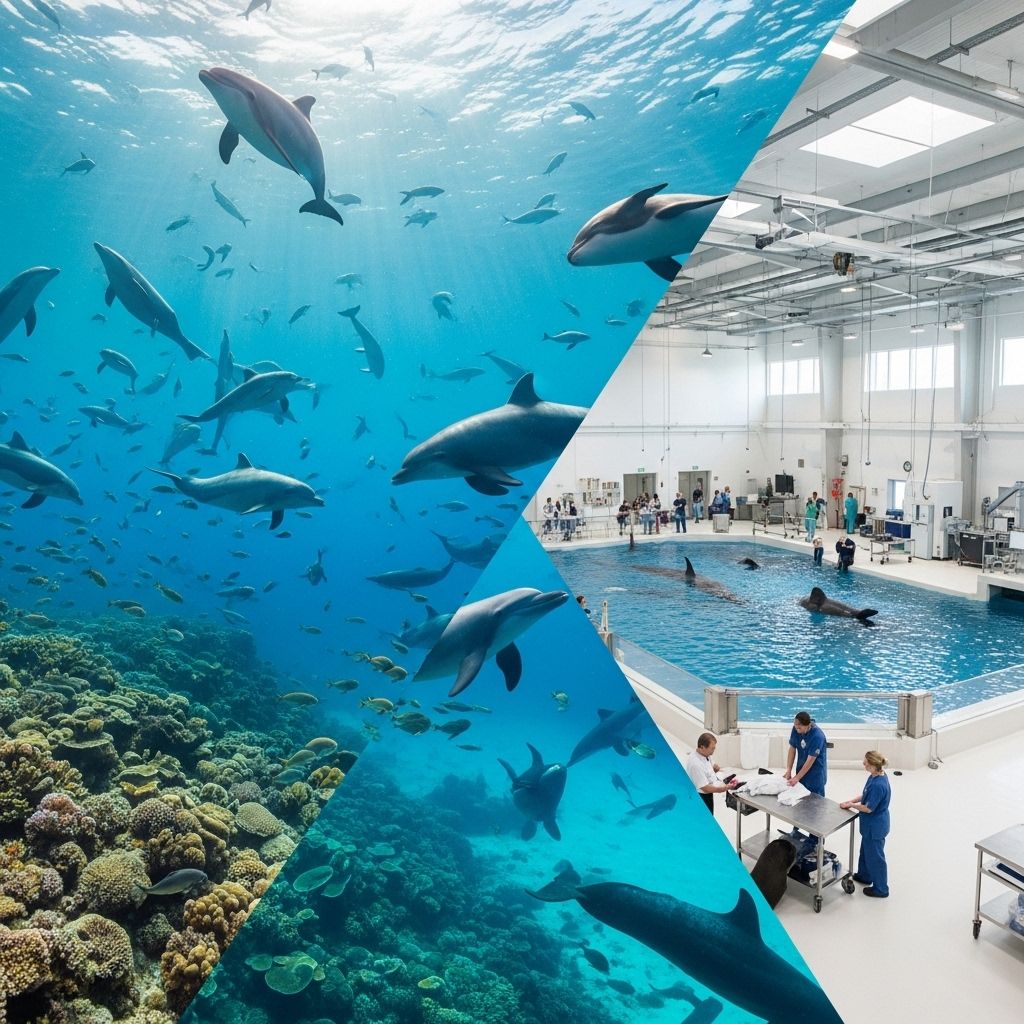Beyond SeaWorld: The Broad Problem of Marine Mammal Captivity
Tank life deprives intelligent aquatic species of key behaviors and natural habitats.

Marine mammal captivity has drawn intense scrutiny over the past decade, ignited in large part by public reaction to exposes like Blackfish and mounting scientific evidence of suffering among orcas, dolphins, and other cetaceans held at facilities around the globe. Yet, focusing solely on SeaWorld obscures the wider landscape of aquariums, dolphinariums, and sea parks implicated in these concerns. This article examines the scope of the problem, the realities faced by captive marine mammals, the myths often perpetuated by the captivity industry, and the complex ethics that underpin public debate.
Table of Contents
- SeaWorld’s Role and the Ripple Effect
- Widespread Marine Mammal Captivity
- Industry Myths and Misconceptions
- Media and Image Reinforcement
- Impacts on Welfare and Behavior
- Risks and Incidents Involving Trainers
- Beyond Entertainment: Conservation Claims and Reality
- Global Landscape of Captivity
- Changing Public Perception and Policy
- FAQs
SeaWorld’s Role and the Ripple Effect
SeaWorld has served as the epicenter for the captive marine mammal debate, particularly following the release of the documentary Blackfish, which exposed the harsh realities of life for orcas like Tilikum. The fallout prompted a reevaluation of company practices and led to shifts in policy—most notably, the discontinuation of orca breeding and theatrical shows in the United States. However, the attention lavished on SeaWorld sometimes masks the industry’s broader issues, as hundreds of orcas and dolphins continue to be housed at facilities worldwide.
Widespread Marine Mammal Captivity
The problem of marine mammal captivity is not unique to SeaWorld. Across North America, Europe, Asia, and beyond, many aquariums and ‘sea parks’ hold orcas, dolphins, and belugas for entertainment and profit. While SeaWorld remains iconic, parks such as the Miami Seaquarium, Marineland, and Loro Parque operate under similar philosophies, often justifying captivity by claiming educational or conservation value.
- Facilities worldwide continue practices of capturing, breeding, and exhibiting marine mammals.
- Many parks are linked by shared business models and persistent welfare issues.
- International transport and exchange of animals complicate oversight and accountability.
Industry Myths and Misconceptions
Marine parks commonly present claims designed to mitigate public concern, many of which have been challenged by independent research and activists. Among the most pervasive myths are:
- Collapsed dorsal fins are natural for orcas: Park guides often claim that fin collapse occurs in “about 50% of all male orcas,” but studies show that in the wild, only 1-5% experience this—the near-universal collapse among captive males is a clear sign of unnatural living conditions.
- Longevity is equal or better in captivity: Captive orcas are frequently said to live as long or longer than wild counterparts, yet mortality and disease rates suggest otherwise.
- Captivity is necessary for education: The notion that seeing dolphins and orcas in tanks is essential for public learning ignores modern alternatives and fails to acknowledge the limitations imposed by artificial environments.
| Industry Claim | Scientific Evidence |
|---|---|
| “Dorsal fin collapse is normal” | Rare (1-5%) in wild males; common (90%+) in captivity. |
| “Captivity ensures better health” | Higher rates of disease, stress behaviors, and premature death compared to wild populations. |
| “Entertainment equals education” | Shows emphasize tricks and human-animal interaction over ecological understanding. |
Media and Image Reinforcement
The media plays a significant role in shaping public perception of marine mammals. Corporations and parks utilize media partnerships and branding to sustain a cheerful, family-friendly image of dolphins and whales. Images and mascots adorn products like tuna cans and toys, reinforcing a narrative of contentment and fun.
- Commercials and advertisements rarely depict the realities of tank life.
- Negative behaviors or suffering are actively hidden or ignored in promotional materials.
- Popular culture perpetuates the notion that captivity is benign or even beneficial.
Impacts on Welfare and Behavior
Scientific studies and firsthand reports indicate damaging consequences for captive orcas and dolphins, including:
- Physical injuries from tank walls and interactions with other stressed animals.
- Abnormal behaviors such as repetitive swimming patterns, self-harm, and aggression.
- Severe psychological stress stemming from isolation, artificial grouping, and lack of natural stimuli.
- Shorter life expectancy and increased infant mortality in captivity compared to the wild.
The emotional complexity and intelligence of species like orcas make them especially vulnerable to the effects of confinement. Social structures are disrupted; breeding, communication, and hunting behaviors cannot be reproduced in tanks.
Risks and Incidents Involving Trainers
While public focus is often on animal welfare, the risks to trainers are substantial. Over 600 pages of documented cases exist detailing injuries to staff at SeaWorld and other parks, some resulting in deaths. High-profile incidents, such as the fatal attacks involving the orca Tilikum, underline the unpredictable consequences of confinement-induced stress.
- Accidents have led to serious injury and loss of life.
- Investigations typically reveal a pattern of underreporting or misattribution by facility management.
- Many incidents occur outside public view, hidden by nondisclosure agreements and internal company policies.
Beyond Entertainment: Conservation Claims and Reality
Facilities frequently invoke conservation and rescue as excusing their captive operations. However, public claims of conservation impact are often overstated. True rehabilitation and release programs exist but are small in scope compared to the entertainment side of business.
- Most captive-born cetaceans cannot be reintroduced to the wild due to lack of survival skills.
- Educational programming is often limited to performance routines and basic facts.
- Leading scientists and animal welfare organizations challenge the notion that captivity supports population viability or conservation awareness.
Global Landscape of Captivity
The captivity issue spans far beyond the United States.
- Europe: Parks continue to display orcas and dolphins with limited welfare oversight.
- Asia: Dolphinariums in Japan and China acquire animals through controversial wild captures and trade.
- Russia and elsewhere: Many countries lack proper legislation, allowing substandard conditions.
International activism is spreading, with growing pressure for reforms on breeding, performing, and acquisition from the wild.
Changing Public Perception and Policy
In recent years, public opinion has shifted dramatically:
- Protests and petitions have targeted major marine mammal facilities.
- Brands and sponsors have distanced themselves from controversial parks.
- Legal reforms have banned or restricted live-capture, breeding, and performance in several regions.
- Documentaries and investigative journalism continue to expose underlying issues and promote alternatives.
- Increasing calls are being made for the creation of sea sanctuaries to house retired cetaceans.
Nevertheless, some facilities remain resistant, investing in larger tanks and new show formats intended to placate critics while keeping core practices unchanged. Innovations such as SeaWorld’s Blue World Project represent attempts at change, but critics argue such efforts may merely modernize captivity rather than eliminate it.
Frequently Asked Questions (FAQs)
Q: Do all aquariums and marine parks treat their animals the same way?
A: No. Standards vary widely, but many commercial facilities exhibit similar welfare problems. Accreditation by reputable organizations may offer some improvement, but issues of confinement and behavioral stress persist.
Q: Why do many captive orcas have collapsed dorsal fins?
A: Collapsed dorsal fins are rare in the wild (1-5% for males) but become common in captivity due to restricted movement, abnormal swimming, and altered water pressure.
Q: Is there any conservation value to keeping dolphins or orcas in captivity?
A: Conservation value is disputed. Most captive programs focus on entertainment, not endangered population support. Few facilities adequately invest in true rescue or research benefiting wild populations.
Q: Have deaths occurred as a result of animal stress in marine parks?
A: Yes. Trainer deaths and injuries have occurred—in many cases linked to stress-induced aggression among captive animals. This risk remains present where animals display abnormal behaviors.
Q: What alternatives exist to watching marine mammals in tanks?
A: Alternatives include virtual reality experiences, documentaries, and whale/dolphin-watching tours in natural habitats. Sanctuaries for retired animals are also gaining traction as a humane alternative.
Key Takeaways and Next Steps
- Captivity-related suffering extends far beyond SeaWorld, affecting marine mammals globally.
- Misinformation and branding mask reality, with educational value often overstated.
- Public and policy pressure are reshaping industry standards but significant challenges remain.
- Consumers and advocates play a vital role in holding institutions accountable.
- Greater awareness, alternative education, and sanctuary models may chart a new path for marine mammal welfare.
References
Read full bio of Shinta












